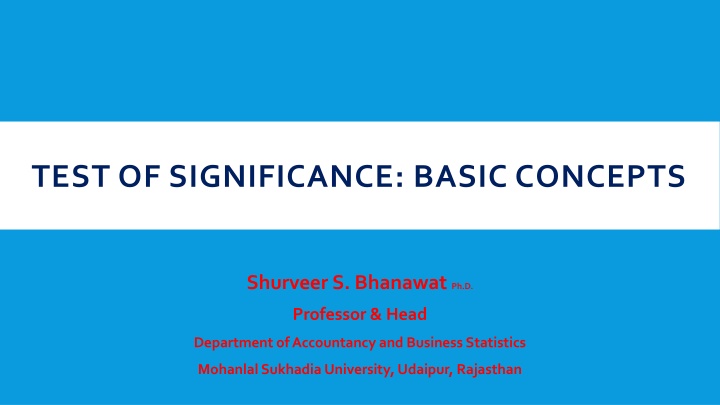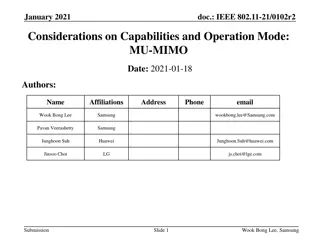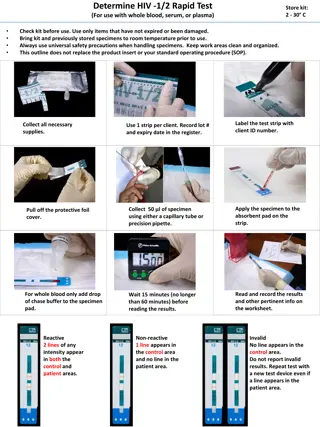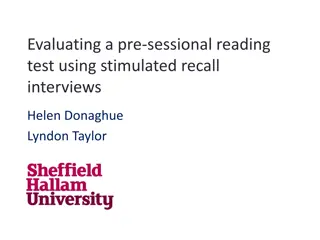
Test of Significance: Basic Concepts
Explore the basic terminologies and concepts related to the test of significance, including population, sample, standard error, hypothesis testing errors, critical values, level of significance, and more. Increase your knowledge in statistics and data analysis.
Download Presentation

Please find below an Image/Link to download the presentation.
The content on the website is provided AS IS for your information and personal use only. It may not be sold, licensed, or shared on other websites without obtaining consent from the author. If you encounter any issues during the download, it is possible that the publisher has removed the file from their server.
You are allowed to download the files provided on this website for personal or commercial use, subject to the condition that they are used lawfully. All files are the property of their respective owners.
The content on the website is provided AS IS for your information and personal use only. It may not be sold, licensed, or shared on other websites without obtaining consent from the author.
E N D
Presentation Transcript
TEST OF SIGNIFICANCE: BASIC CONCEPTS Shurveer S. Bhanawat Ph.D. Professor & Head Department of Accountancy and Business Statistics Mohanlal Sukhadia University, Udaipur, Rajasthan
BASIC TERMINOLOGIES USED Population Level of significance Sample Critical value Parameter P-Value Statistic Standard error Hypothesis One tailed and two tailed Errors in Hypothesis Testing
Particulars Population Sample No. of Items N n TERMINOLOGIES Mean X S.D. s Proportion P p Parameter Statistic Statistical Objective Census Vs Sampling Estimation Testing Hypothesis Point Interval
TERMINOLOGIES Standard Error : Standard deviation of sampling distribution of a statistics is known as its standard error. It provide the measurement of variation of statistic (measurement of sample) from parameter (measurement of population) Standard Deviation : The measurement of variations on both side of arithmetic mean of original values is known as standard deviation
ERRORS IN HYPOTHESIS TESTING Null Hypothesis s Accept Reject Type I error =P(rejecting a good lot) Producer s Risk True Correct Decision Null Hypothesis Type II error =(Accept a bad lot) Consumers Risk False Correct Decision
TESTING HYPOTHESIS On the basis of Critical Values Calculated Value > Critical Value Reject Calculated Value < Critical Value Accept On The basis of p-Value: p-Value > Level of Significance Accept P-Value < Level of Significance Reject
RELATIONSHIP AMONG CRITICAL VALUE, LEVEL OF SIGNIFICANCE & LEVEL OF CONFIDENCE Area Covered Critical Value Level of Confidence Level of Significance Two tailed one tailed Mean S.D. 1 68.27% 31.27% 1.645 Mean 1.96S.D. 1.96 95% 5% Mean 2 S.D 2 95.45% 4.55% 2.33 Mean 2.58 S.D. 2.58 99% 1% Mean 3S.D. 3 99.73% 0.27%
DETERMINATION OF CRITICAL VALUE at 5% level of significance 0.5-.025=0.475 corresponding Z score is 1.96 0.475 0.475
DETERMINATION OF P VALUE X - Mean Z= S.D. The p value is determined using the standard normal table. The area between the mean and a Z value is found, then such area is subtracted from 0.5, the resultant figure is p value. For example value of Z comes 2.5 (1.96). The area between mean and Z value i.e. 2.5(1.96) is 0.4983 (0.4750) (derived from standard normal table). So p value for one tailed test would be 0.5 0.4983 = 0.0017 and for two tailed test it would be 0.0017*2=0.0034
PROBABILITY VALUES (P VALUES) Hypothesis can be accepted or rejected on the basis of p values. p value method of presenting the result of a statistical test report the extent to which the test statistic disagree with the null hypothesis. This method has become popular because analysts want to know what percentage of the sampling distribution lies beyond the sample statistic on the curve. Most of the statistical computer programs report the results of statistical tests as probability values (p values). the p value is the probability of observing a sample value as extreme as , or more extreme than, the value actually observed, given that null hypothesis is true. This area represents the probability of a type I error that must be assumed if the null hypothesis is rejected.
ONE TAILED AND TWO TAILED TEST When rejection area lies on both side of normal curve is known as two tailed test. It is also called non directional test. When rejection area lies on either side of normal curve is known as one tailed test
PARAMETRIC TEST The observations should be drawn from normally distributed population Random selection of sample The measurement scale should be at least Interval or Ratio scales data
NON-PARAMETRIC TESTS The NPTs are useful under the following conditions Not Normal Distribution Nominal or ordinal scaled data Incomplete or partial data Very small samples
HOW TO SELECT A TEST In attempting to choose a particular significance test, the researcher should consider at least three questions: 1. Does the test involve one sample, two sample or k samples? 2. If two samples or k samples are involved, are the individual cases independent or related? 3. Is the measurement scale nominal, ordinal, interval or ratio? Others 1. What is the sample size? 2. Have the data been transformed?
RECOMMENDED STATISTICAL TEST Measurement One sample case Two sample case Independent samples Chi square k- sample case Independent samples Related samples McNemar Related samples Cochran Q Chi level Nominal Binomial square for k samples Chi square Kolmogorov- smirnov Ordinal Sign test Median test Friedman two-way ANOVA Median Kruskal-wallis extension Wilcoxon matched pairs Mann-Whitney test smirnov test t test U Run test Kolmogorov- one way ANOVA Interval Ratio and t test t paired samples test for ANOVA One way & N-way ANOVA Z test Z test
PROCESS OF HYPOTHESIS TESTING 1. Formulation of Hypothesis 2. Set the level of significance 3. Determination of suitable Significant test 4. Determine the critical value 5. Decision: Interpret the test 6. Measuring the power of test
SMALL CASE STUDY A marketing research firm conducted a survey 10 years ago and found the average household income of a particular geographic region was Rs. 10,000. Mr. Bhatanagar, who has recently joined the firm as a vice president has expressed doubt about the accuracy of the data. For verifying the data, the firm has decided to take random sample of 200 households that yield a sample mean (for household income) of Rs. 10200. Historical data shows that population standard deviation of the household income is Rs.1200. Verify the Mr. Bhatanagar s doubt at 5% level of significance.
STEP 1 SET NULL HYPOTHESIS OR ALTERNATE HYPOTHESIS The null hypothesis is set as no difference or status quo that is, the average of household income has not changed. Or there is no difference between average value of household income ten years ago i.e. Rs.10000 and average value of household income derived i.e. Rs.10200 recently.
STEP 2 SET THE LEVEL OF SIGNIFICANCE: ALREADY GIVEN = 5% STEP3: DETERMINE APPROPRIATE TEST Sample size is greater than 30 and sample mean is used as statistic, so the Z test can be used for hypothesis testing. i.e. Test of significance of single mean Z = 10200-10000/ 1200 200 = 2.36 Note: 1. if population standard deviation remains unknown then sample standard deviation can be used. The z formula is based on the assumption that the sample is drawn from an infinite population.
STEP 4: TESTING THE HYPOTHESIS By using critical value approach The calculated value of Z is 2.36 which is greater than critical value of 1.96 at 5% level of significance. Hence null hypothesis is rejected. On the basis of hypothesis testing, it can be concluded that the average household income of the particular geographic region is not Rs.10000. Mr. Bhatanagar s doubt about this average household income was right.
BY USING P-VALUE APPROACH The p-Value approach for hypothesis testing is used for large samples and is sometime referred to as observed level of significance. This approach is very advantageous especially after the introduction of many statistical software programmes. Here the value of p is 0.0182 ((0.05-0.4909)*2) i.e. less than 0.05 hence null hypothesis is rejected. The observed test statistics is computed as 2.36, from the normal table, the corresponding probability area for z 2.36 is 0.4909. so, the probability of obtaining a Z value greater than or equal to 2.36 is 0.5000- 0.4909 = 0.0091 for a two tailed test, this value is multiplied by 2. Thus for a two-tailed test, this value is (0.0091*2= 0.0182). it has to be noted that for =0.05, the null hypothesis is rejected because 0.0182 is less than 0.05
SETTING THE LIMITS Limits = 10000 + 1,96* 1200 200 = 10000+ 1.96*84.86 = Rs. 9833 Rs10167 Sample mean i.e. 10200 is out of range hence null hypothesis is rejected
MEASURING THE POWER OF TEST It is quite important to know how well a hypothesis test is working. The measure of how well the test is working is called the power of the test. Rejection of hypothesis means we run a risk of committing an error of type I but acceptance of null hypothesis means we run some risk of committing an error of type II. The probability of type one error is denoted by (level of significance) and the probability of type II error is referred as . Usually significance level of a test is determined in advance and once we decide it, there is nothing else we can do about alpha. Hypothesis test can not be fool proof: sometimes the test does not reject null hypothesis when it happens to be a false and this way a type II error is made. But we would certainly like the probability of accepting null hypothesis when it is not true i.e. to be as small as possible. Alternatively, we would like that 1- to be as large as possible. If 1- is very much nearer to unity ( i.e. nearer to 1). We can infer that the test is working quite well, and if 1- is very much nearer to 0m then we infer the test is poorly working.
DECISION: INTERPRET THE TEST The computed value of test statistic ( Z,t,F, etc) is compared with the tabulated value (Z,t, F) at the given level of significance. In case of parametric test if calculated value of statistic is greater than critical value (at 5% 1.96 and at 1% 2.58) then null hypothesis is rejected otherwise accepted. In case of non parametric test critical value is derived from corresponding table at given degree of freedom and level of significance. If calculated value of statistic is less than derived table value, null hypothesis is accepted otherwise rejected. Simultaneously hypothesis can also be tested on the basis of p values. If the p value is less than the significant level, the null hypothesis is rejected, if p value is greater than or equal to the significance level, the null hypothesis is not rejected. Null hypothesis is rejected means difference between parameter and statistic is significant and there is a good reason to believe the difference does not represent random sampling fluctuations only. Null hypothesis accepted means visible difference is available only due to chance or sampling fluctuations not due to major reasons.






















